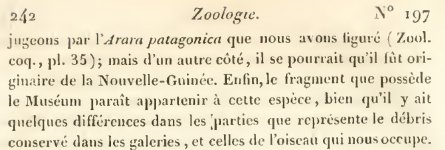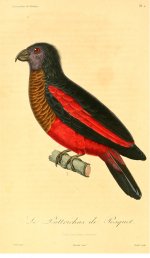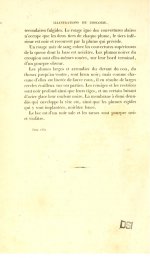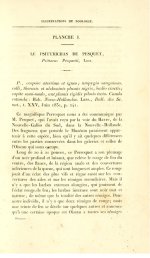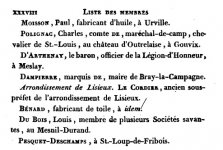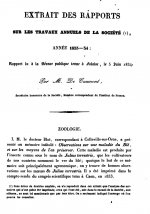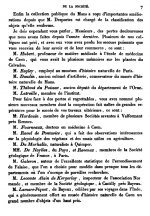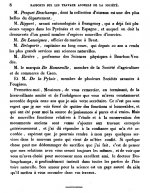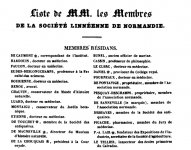Björn Bergenholtz
(former alias "Calalp")

Here´s another long and lingering Post, regarding a true Mystery Man … who we might solve with help by our French knowing readers!
Or does anyone already know the man behind the Common name Pesquet’s Parrot Psittrichas fulgidus?
This species was described by The French ornithologist Lesson, firstly in 1830, as "BANKSIEN NOIR ET ROUGE; Banksianus fulgidus" (whithout a word of any persons involved), and again(!) by the same Lesson, in 1831 (1832), as "LE PSITTRICHAS DE PECQNET, Psittacus Pecquetii” (excerpts attached) that later turned out to be the same Species. In this description, of the latter, Lesson writes:
I guess there must be some kind of mishap or typo behind it all?
Even Lesson seem to have realized the confusion he had caused, since he in June 1831 (published in 1832) once again (!) wrote about the same "species" … this time under the head-line "”LE PSITTRICHAS DE PESQUET, Psittacus Pesquetii”. " (Attached; Plate, and its un-paginated text). The text is more or less the same as his earlier one (above), but he changed the beginning sentences to:
With only limited knowledge (close to none!) of French I hope that any of Bird Forums readers feel like translating those two quotes for me!? If so, please as accurate as possible, as I would like to quote them myself in Swedish. And don´t hesitate to remark on any errors that I might have done transcribing it.
Anyone feel up to it?
Anybody know who the poor sod in the middle of this mishmash really was? And how he actually spelled his name? Do we even know, for certain, that he was French?
Anybody?
PS. Later it turned out as fulgidus simply being the Male and "Pesquetii" the Female! And don´t hesitate to remark if you think I have missunderstood or gone astray in the twist and turns behind the name/s of this "his" Parrot.
PPS. Is he maybe the same person as the French Collector "Pesquet-Deschamps, à Caen" mentioned by Lesson and Buffon, as well as others, in and about the 1830's (from 1929 to 1838)?
Or does anyone already know the man behind the Common name Pesquet’s Parrot Psittrichas fulgidus?
This species was described by The French ornithologist Lesson, firstly in 1830, as "BANKSIEN NOIR ET ROUGE; Banksianus fulgidus" (whithout a word of any persons involved), and again(!) by the same Lesson, in 1831 (1832), as "LE PSITTRICHAS DE PECQNET, Psittacus Pecquetii” (excerpts attached) that later turned out to be the same Species. In this description, of the latter, Lesson writes:
So here we suddenly have three(!) different spellings of the name of the person involved: Monsieur Pesquet (in its modern English, as well as in its French, name; Psittrichas de Pesquet), and Lesson's Monsieur Pecquet (in the Scientific name) and Monsieur Pecqnet (in both the first French Common name and in text of it)!"Ce magnifique perroquets nous a été communique par M. Pecqnet, qui l’avait reçu par la voie du Hàvre, avec beaucoup d’oiseaux de la Patagonie et du territoire de la Plata. Son plumage indique un oiseaux du Sud de la Patagonie, si nous en jugcous par l’Arara patagonica que nous avons figuré (Zool. coq., pl.35); mais d’un autre côté, il se pourrait qu’il fùt originaire de la Nouvelle-Guinée. Enfin, le fragment que possède le Muséum paraît appartenir à cette espèce, bien qu’il y ait quelques différeances dans les parties que représente le débris conservé dans les galeries, et celle de l’oiseauu qui nous occupe."
I guess there must be some kind of mishap or typo behind it all?
Even Lesson seem to have realized the confusion he had caused, since he in June 1831 (published in 1832) once again (!) wrote about the same "species" … this time under the head-line "”LE PSITTRICHAS DE PESQUET, Psittacus Pesquetii”. " (Attached; Plate, and its un-paginated text). The text is more or less the same as his earlier one (above), but he changed the beginning sentences to:
In trying to figure out the truth of this chaos, or at least understand some more of it, I now need some help from you guys "out there" …” ... par M. Pesquet, qui lʼavait reçu par la voie du Havre, de la Nouvelle-Galles du Sud, dans la Nouvelie-Hollande. Des fragments que posséde le Muséum paraissent appartenir à cette espèce, bien quʼil y ait quelques différences entre les parties conservées dans les galeries et celles de lʼOiseau qui nous occupe.”
With only limited knowledge (close to none!) of French I hope that any of Bird Forums readers feel like translating those two quotes for me!? If so, please as accurate as possible, as I would like to quote them myself in Swedish. And don´t hesitate to remark on any errors that I might have done transcribing it.
Anyone feel up to it?
Anybody know who the poor sod in the middle of this mishmash really was? And how he actually spelled his name? Do we even know, for certain, that he was French?
Anybody?
PS. Later it turned out as fulgidus simply being the Male and "Pesquetii" the Female! And don´t hesitate to remark if you think I have missunderstood or gone astray in the twist and turns behind the name/s of this "his" Parrot.
PPS. Is he maybe the same person as the French Collector "Pesquet-Deschamps, à Caen" mentioned by Lesson and Buffon, as well as others, in and about the 1830's (from 1929 to 1838)?
Attachments
Last edited:





